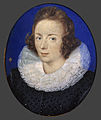Isaac Oliver

Isaac Oliver (c. 1565 – bur. 2 October 1617) or Olivier was an English portrait miniature painter.[1][2][3]
Life and work
[edit]Born in Rouen around 1565, he moved to London in 1568 with his Huguenot parents Peter and Epiphany Oliver to escape the Wars of Religion in France. He then studied miniature painting under Nicholas Hilliard; and developed a naturalistic style, which was largely influenced by Italian and Flemish art. His first wife, Elizabeth, died in 1599. With her he fathered Peter Oliver, who was also eminent in miniature painting. In 1602, he married Sara, daughter of the well-known portrait painter Marcus Gheeraerts the Elder (c. 1520 – c. 1590) and his wife Susannah de Critz. Susannah was the daughter of Troilus de Critz, a goldsmith from Antwerp, and close relative of John de Critz, the Queen's Serjeant-Painter. She was also the eldest sister or cousin of Magdalen de Critz, who married Marcus Gheeraerts the Younger (1562–1635).
After the death of Elizabeth I, he became a painter of James I's court, painting numerous portraits of the queen Anne of Denmark and Henry Frederick, Prince of Wales. He accompanied Anne of Denmark on her progresses in Oxfordshire, Berkshire, and Kent in 1605, and was appointed "her Majesties painter in the art of lymning".[4]
Oliver died in London in 1617 and was buried at the church of St Ann Blackfriars, which was destroyed in the Great Fire of London.[1]
Some of his work is housed in Windsor Castle. Some of his pen drawings are located in the British Museum.
Gallery
[edit]Portrait miniatures
[edit]-
Portrait of a Young Gentleman (possibly Sir Philip Sydney), 1605
-
Unknown Woman in Masque Costume, 1609
-
Philip Herbert, Fourth Earl of Pembroke, 1611
-
Charles I as Prince of Wales, 1615
Larger works
[edit]-
Richard Sackville, 3rd Earl of Dorset, cabinet miniature, 1616
See also
[edit]References
[edit]- ^ a b Lee, Sidney, ed. (1895). . Dictionary of National Biography. Vol. 42. London: Smith, Elder & Co. pp. 145–6.
- ^ Macfall, Haldane. A history of painting, volume 7 (Boston: Estes, 1912) pp. 40–41.
- ^ Baskett, John. Paul Mellon's legacy: a passion for British art (Yale University Press, 2007) pp. 240–1.
- ^ Jemma Field, Anna of Denmark: The Material and Visual Culture of the Stuart Courts (Manchester, 2020), p. 162.
External links
[edit]- Williamson, George Charles (1911). . In Chisholm, Hugh (ed.). Encyclopædia Britannica. Vol. 20 (11th ed.). Cambridge University Press. p. 88.
- . Dictionary of National Biography. London: Smith, Elder & Co. 1885–1900.
- Isaac Oliver online (ArtCyclopedia)
- Three Louvre miniatures recently attributed to Isaac Oliver Archived 26 September 2015 at the Wayback Machine (The Art Tribune – 20 Sep. 2008)
- "Nicholas Hilliard & his Pupil Isaac Oliver". Paintings & Drawings. Victoria and Albert Museum. Archived from the original on 13 July 2007. Retrieved 21 August 2007.
- 6 artworks by or after Isaac Oliver at the Art UK site







